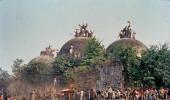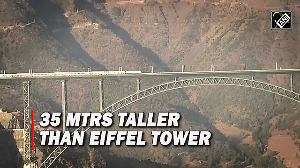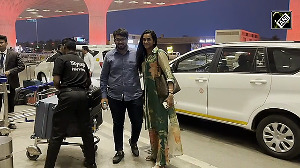'It is entirely possible that there are many treasures of our history and our faith buried deep underground,' points out Rajeev Srinivasan.

Now that the initial euphoria about the Supreme Court judgment over the Ram Mandir has died down, it is time to take a more rational look at the way forward. There are several issues to consider, as I discussed with old friend and classmate, Naras:
First, should the construction proceed with no thought to the artifacts beneath?
Second, should the design of the temple be revisited?
Third, what is the governance model?
Design and construction
The first and the second are closely related. There is a working design, and shilpis have been hard at work for decades, carving the stone pillars in anticipation of the judgment.
There are two compelling arguments to proceed post-haste with the construction of the temple.
The first is that it fulfills the dreams of thousands of bhaktas who have been waiting for this moment with bated breath; and that it honours the memory of the anonymous, ordinary Hindus who gave their lives for their ishta-devta.
The second is that it is important to create 'facts on the ground'.
Once the temple is built, it is hard to undo it. It is not out of the realm of possibility that the court will consider a review petition and do a significant U-turn. Best to create a fait accompli.
But there is a significant counter-argument, which is that we have a once-in-a-lifetime opportunity to explore what is buried under the Ram Janamsthanam. After all, a little bit of archaeological digging by Dr B B Lal and K K Mohammed led to the unearthing of a lot of history.
What lies in the levels below? Undoubtedly, since it has been a point of singular significance for Hindus for several thousand years, it is entirely possible that there are many treasures of our history and our faith buried deep underground.
Wouldn't it make sense to take this opportunity to dig deeper before construction? Heinrich Schliemann's digs at Troy revealed nine layers of earlier inhabitation. If you dig up the Purana Qila in Delhi, the seven ancient cities beneath it, going all the way to Indraprastha, will be unearthed.
I, for one, would dearly love to know what is there in Ayodhya. The inevitable effects of gravity -- stone sinks slowly -- mean that ancient structures would have disappeared further and further underground over time.
Since the entire written history of northern India was lost when invaders burned the libraries at Nalanda and other universities, there is a giant gap in our knowledge of the past. Imperialists and Communists later filled this vacuum with utter garbage.
As we know, it is not the Muslims who objected to the Ram Mandir, it was the Communists who chivvied them on to take a hardline stance, assuring them that a Congress government would be in power and would always favour Muslims.
Occasional archaeological digs have brought welcome news that overturns some of this 'conventional wisdom'. For instance, the discovery of a 4,000-year-old solid-wheel war chariot in Sanauli, UP, suggests that they, and horses to draw them, were known in India.
We have no idea what even a limited dig at Ayodhya for six months might bring. But the time has to be now.
Yes, it is true that recent advances in airborne laser scanning and ground-penetrating radar may help map out subterranean features.
The new technology helped archaeologists discover a metropolis in the vicinity of Angkor Wat in Cambodia, now covered with dense jungle, dangerous because of landmines.
But that would still be a vicarious pleasure. There is nothing like unearthing history, and then having them on display, as the Chinese have done with their terra-cotta warriors in Xian.
With ground-penetrating radar, I doubt if we'd have the resolution and granularity to make 3-d virtual models or holograms of these long-forgotten artifacts, assuming they exist.
Therefore, while it is important to have the emphatic fact on the ground of the temple as soon as possible, it may be sensible to do a quick dig with the best available technology and deadlines.
The question of the design of the temple is a related issue. To be honest, I am not impressed by the artists's impressions of the Mandir planned. I would have imagined a truly grand structure, in my humble opinion a bit like Brihadeeswara or Akshardham. This is more modest.
It is going to attract a tsunami of pilgrims, so it better be very large and planned for smooth foot traffic. It is desirable to design it from scratch to facilitate a good experience. I have experienced the crowds at Sabarimala and Guruvayur which have exceeded their carrying capacity.
Furthermore, there is 67 acres of land now available, including the core 2.7 acres of the actual janamasthan.
Governance
What exactly is going to be the governance model of the Ram Mandir? I believe the Nirmohi Akhara, which had quite a good claim to manage it, has been totally sidelined by the judgment.
So are we going to end up with another sarkari-run temple, with babus making the decisions? If so, then we have lost. #LetMyTemplesGo is a big cause, even, some might say, bigger than the Ram Mandir itself.
We have seen how Devaswom boards, HRCE and state governments have treated temples as entities for them to steal money from and grab land from.
There has to be a precedent set with the Ram Mandir. The deity is a legal person, the court has held. As such, the deity has the right to own the temple property, and to ensure that it is not alienated. A corollary is that the government has no rights whatsoever over the temple.
That principle has to be upheld in full, so that the stranglehold of politicians over Hindu temples, and only Hindu temples --- a perversion of the apartheid Constitution -- is broken forever.
Then who runs the temple? Why, let us take a leaf from the churches and mosques that are left to their own devices, with the community of believers running them. Guidelines must be drawn up for representatives of the faithful to be chosen, who will have certain freedoms.
Then and only then, will we have pushback on the millennium-old attacks on Hindu temples.











 © 2025 Rediff.com -
© 2025 Rediff.com -